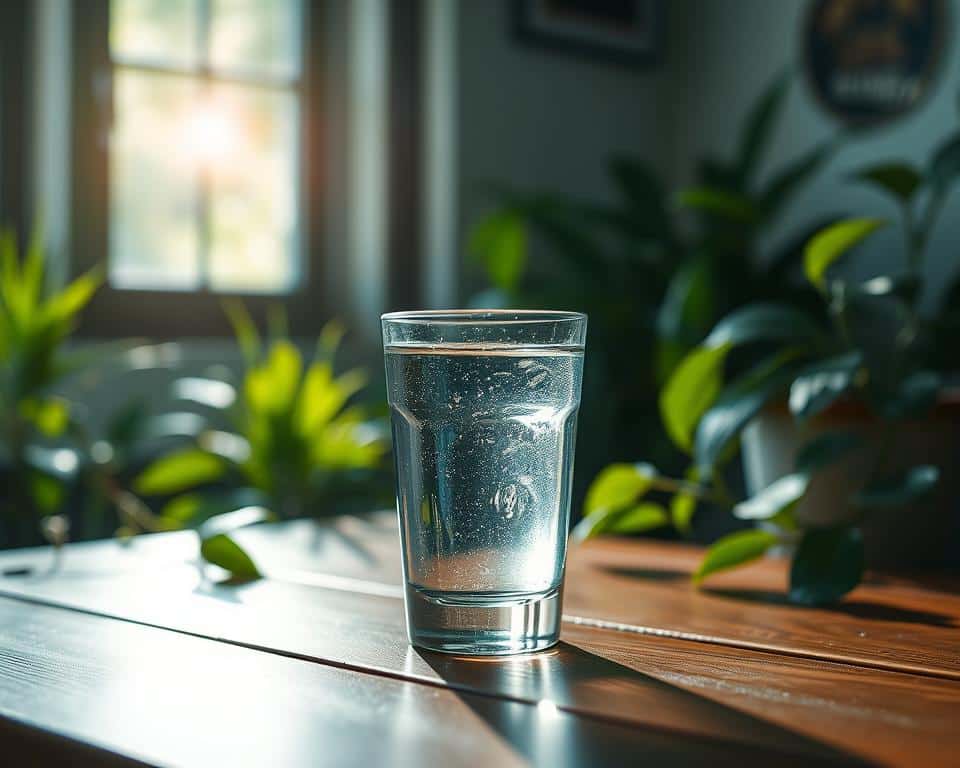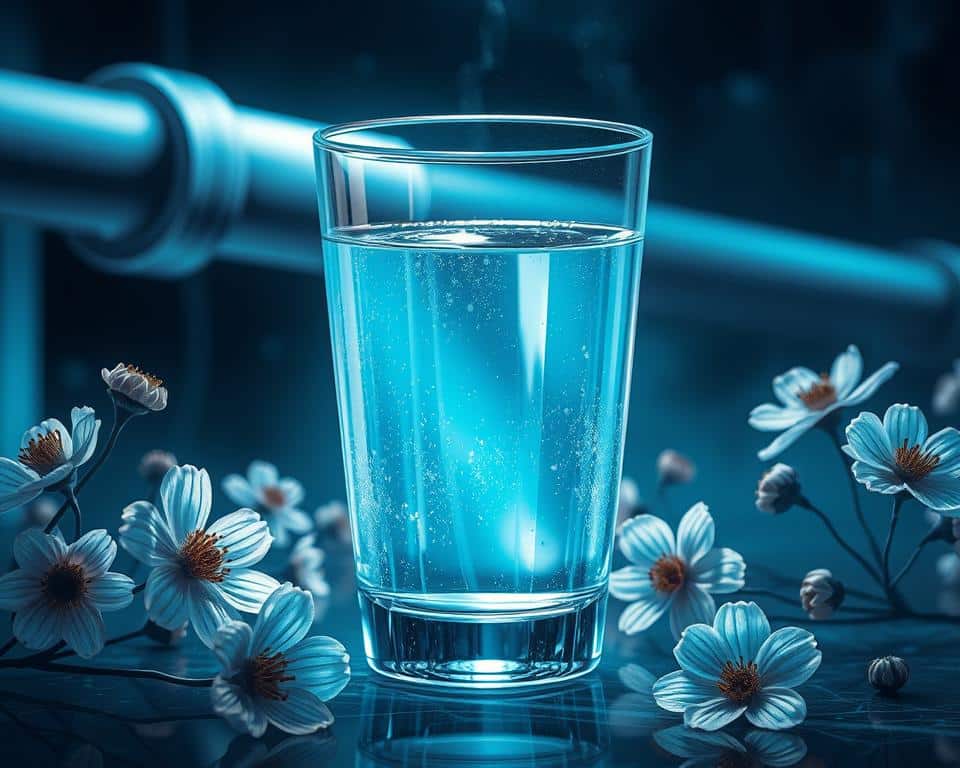Lead in drinking water is a hidden danger. It can enter our water from old pipes and poor water treatment. This problem is most common in places with old buildings.
Efforts to get rid of lead pipes have helped. Yet, many people still face risks. The EPA warns there’s no safe level of lead. Kids under six are at high risk. Lead can harm brain development and lower a child’s IQ.
Keeping water safe is key to fighting lead poisoning. Testing water, updating pipes, and better water treatments can help. W knowlead’s dangers, taking action and spreading the word are key steps to prevent it.
How Lead Gets Into Our Drinking Water
Lead in drinking water is a big health risk for millions. It’s found in the earth but gets into water through human actions and old water systems. We’ll look at how lead pollutes our water and the main reasons behind it.
Corrosion of Lead Plumbing
Lead mainly gets into water through corroding lead pipes and fixtures. This happens when water reacts with lead in pipes. The water’s acidity, materials dissolved in it, temperature, and how long it sits can make corrosion worse. Even “lead-free” fixtures may have up to 8% lead.
Replacing lead service lines is key to solving this problem. Around 9 million such lines in the U.S. still serve about 22 million people. While filters help, removing the lines entirely is the best solution. For more on fixing water wells, check this guide.
Inadequate Municipal Water Treatment
Poor water treatment adds to the lead problem. If corrosion control isn’t done right, lead levels can rise. Corrosion control means adding materials to water to stop lead dissolving in it. The EPA and local bodies watch over these treatments to reduce risks.
The EPA thinks drinking water could be 20% of our lead exposure. Strong rules and frequent water checks, especially for at-risk groups like pregnant women and babies, are crucial to avoid lead exposure.
Health Risks Associated with Lead Exposure
Lead exposure can deeply affect adults and children. Knowing these risks helps us find better ways to treat and prevent lead problems.

Effects on Adults
Adults exposed to lead can face many health issues. It can increase their chances of getting cancer, high blood pressure, and kidney problems. It can also cause thinking problems, making daily life hard.
Lead poisoning symptoms include tiredness, pain in muscles and joints, high blood pressure, and headaches. To lower these risks, finding and stopping lead exposure is key. Changes in lifestyle, diet, and sometimes chelation therapy are needed. Using special filters for water can also help.
Effects on Children
Lead exposure is very harmful to kids. They take in more lead than adults, which can harm their growth. Signs of lead poisoning in kids are crankiness, tiredness, stomach pain, and slow development.
Babies using formula with lead-tainted water are at a higher risk. No amount of lead is safe for kids, so we aim for zero. Safe drinking water and testing are critical to keep them safe.
Identifying Sources of Lead in Water
Finding where lead in drinking water comes from is key to protect our health. Trace amounts of lead can harm us, especially kids. Different places can be the source, so checking the entire water system is critical.
Lead Service Lines
Lead service lines are a major lead source in water. Used often before 1986, they were chosen for their long life and not rusting. But, corrosive water can make lead mix into the water, creating health dangers. Cities with older pipes usually find more lead in water. This shows why we must always test our water.
Household Plumbing Fixtures
Household fixtures also add lead to water. Even new “lead-free” ones can have a bit of lead. This lead can get into water if it’s very corrosive. It’s important to test water in homes often. This is especially true for houses with old or different kinds of pipes.
Industrial Activities
Industry work can also lead to lead in water. Lead-using industries might accidentally add lead to water through spills or not cleaning wastewater well. Stopping industrial leaks is key in keeping water clean. Testing water often helps find and fix lead problems from industries.
It’s crucial to always check for lead and plan how to remove it. Making sure our drinking water is safe is very important. We should always focus on its quality and safety.
Safe Levels of Lead in Drinking Water
Keeping our drinking water safe is very important, especially with the risk of lead. It’s vital to know safe lead levels to prevent lead poisoning. The EPA says the safest level of lead in water is none at all.

Public water systems must act if lead levels go above 0.015 milligrams per liter. If lead is found in over 10% of samples, systems must alert people and reduce lead in water.
The U.S. Food and Drug Administration sets a strict lead limit for bottled water at 0.005 milligrams per liter. This shows a strong commitment to keeping water safe and protecting health.
| Agency | Lead Limit (mg/L) | Action Required |
|---|---|---|
| EPA | 0 | Target MCLG for optimal safety |
| Lead and Copper Rule | 0.015 | Notification and reduction measures if over 10% samples exceed limit |
| FDA | 0.005 | Limit for bottled drinking water |
Places like New York State have strict laws for schools to test water for lead. Schools must act fast to keep students safe if lead levels are too high.
While these rules help keep water safe, we can do our part too. Testing water at home and working with local health experts can help make sure our water is safe for everyone.
Reducing Lead Exposure in Drinking Water
Lead in drinking water is a big health issue. It needs quick action to lower exposure. Comprehensive plans can make our water safe and clean. Here are key steps to reduce lead in water:
Testing Your Water
Testing water for lead is the start. Lead can’t be seen or tasted, so tests are vital. Use first-draw and running samples to find lead in your system. You can test your water for lead yourself following easy steps. Or get a pro to do it for accurate info. The EPA makes strict rules for less lead, making testing very important.
Replacing Lead-containing Fixtures
It’s important to swap out lead fixtures. Lead pipes and plumbing are often to blame. Get a professional to replace them to take all lead out well. Half-way changes can actually raise lead levels for a bit. Experts can tell you what needs changing to make water safer. Doing this is key in cutting down lead in water.
Regular Flushing of Pipes
Flushing pipes often lowers lead in water. It’s simple but works well. Just run cold water for a few minutes before using it. This is best in the morning or if the water hasn’t been used in a while. Cold water is less likely to have high lead. Also, use filters that are meant to get rid of lead. They’re approved by groups like the Water Quality Association or NSF International. Actions like these keep drinking water safe.
Here’s how different methods stack up:
| Intervention | Description | Effectiveness Rating |
|---|---|---|
| Lead Water Test | Detects the presence of lead in water through samples. | High |
| Pipe Replacement | Removes lead-containing pipes and fixtures. | Very High |
| Regular Flushing | Runs cold water to flush out lead particles. | Moderate |
Using these methods and pushing for better water systems can cut down lead exposure. This makes sure our drinking water is safe for everyone.
Conclusion
Lead in drinking water is a hidden danger that needs immediate action and awareness. In Chicago, a daunting 68% of kids under 6 are at risk because of lead in their water. And 19% of these children drink straight from unfiltered taps.
Communities of color, especially Black and Hispanic ones, are more vulnerable. They often get left out when checking for lead. This situation calls for change.
To tackle this, actions such as regular water tests and fixing lead pipes are vital. Under-sink filters, for instance, can cut lead by up to 98%. Also, joining municipal water services can make water safer. This was shown to reduce lead in water by 92.5% in a study.
The Bipartisan Infrastructure Law of 2021 is a big step forward. It aims to improve water services for communities, which could help lower lead exposure.
Raising awareness about the dangers of lead is crucial. The World Health Organization says lead causes around 500,000 deaths a year. We need to work on spreading the word, managing water systems better, and educating people. This way, we protect everyone’s health.
If we come together, we can lessen the threat of lead in our water. This will help make drinking water safer for everyone. Discover more details about public health.

